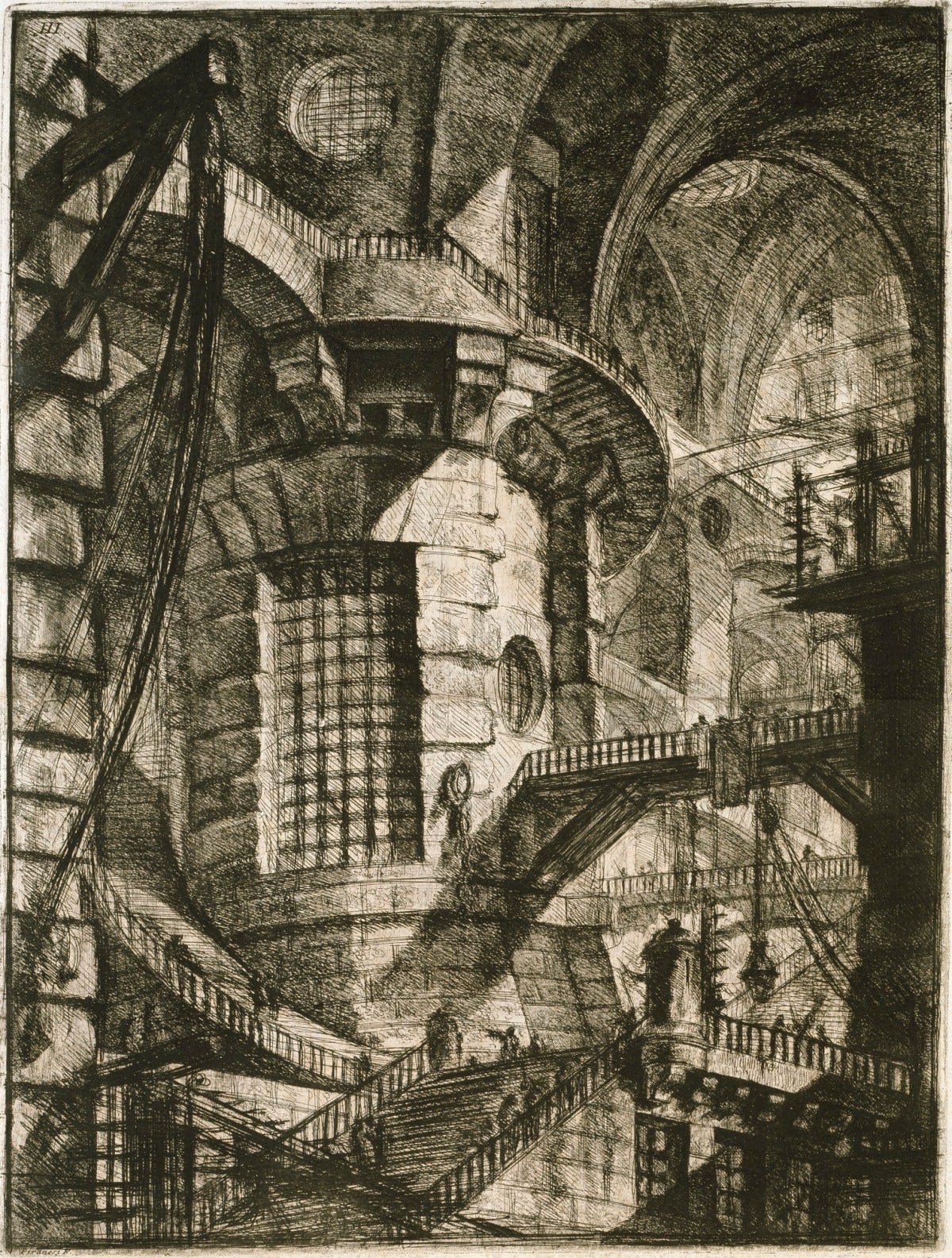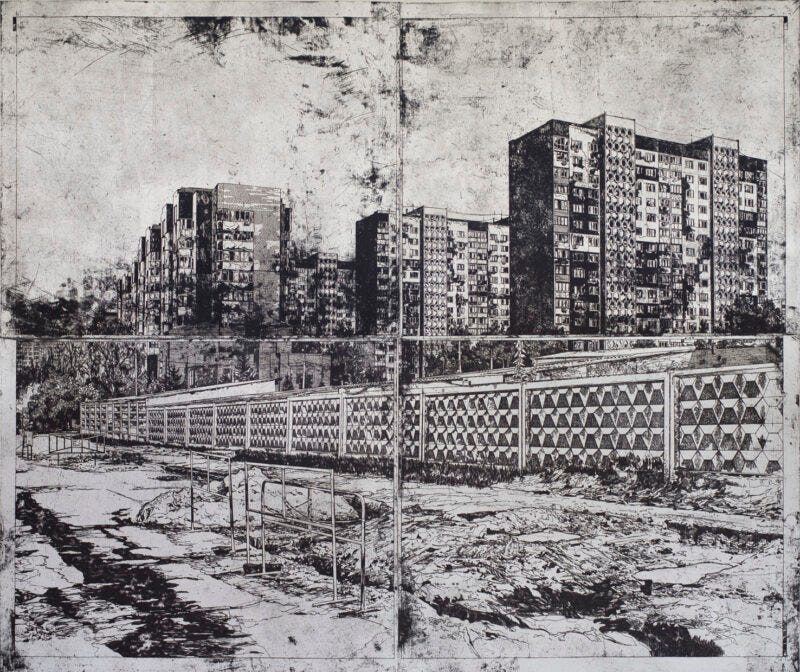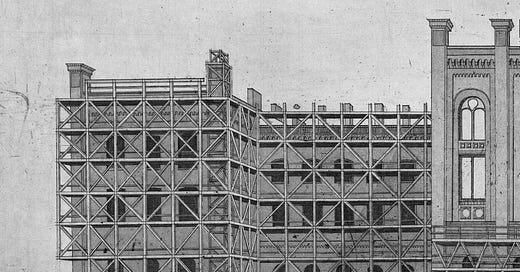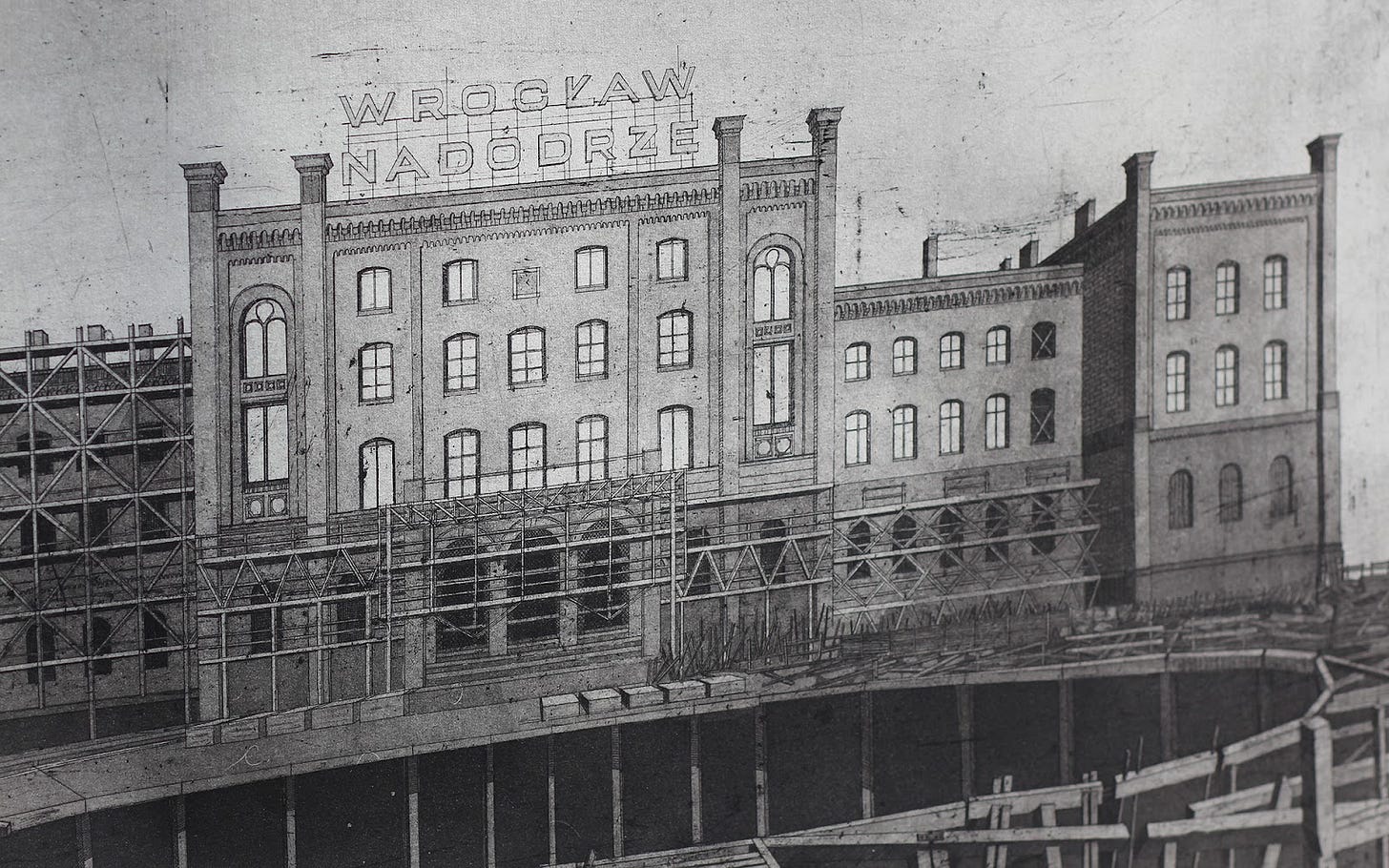There are images that incapsulate time in finite quantities. For example when looking at an old photo our brain inconsciously calculate a span of time (let’s say a package of time) that resides in that image, making us feel melanchonic, happy or sad depending on the subject portrayed. Today we’ll have a look at a short-circuit of this process.
Only for the Takeovers my text will be in italic, just to distinguish it from the guest’s. My name is Federico and welcome to Representations of Architecture #35.
Intro
When looking at Vinicius Libardoni’s images my brain rebooted several times. It’s the same thing that happened to me when I saw the architectures depicted by Hieronymus Bosch in his “The Garden of Earthly Delights”. Something was off: it was a classical painting but inside there were shapes completely out of time1. In the same way in Libardoni’s engravings a moment from a near past is fixed in time. Nothing out of the ordinary compared to Bosch’s, but what short-circuited my mind was the absolutely incredible quality of the engraving technique. That really belongs to past times, making me believe for a short (infinitesimal) moment that those architectures were actually modern casualities built a couple of centuries ago. The “package of time” was altered.
But that’s just my impression.
Today, for you, a glimpse into the mind of Vinicius Libardoni.
Insights
Hi there, thanks for having me!
My story with architecture started a while ago, but let's just say it began to get more interesting quite recently. And this change had come precisely at the moment when I decided to step down from my career as an architect. After nearly a decade working for five different architecture practices, I concluded that I had seen enough, or rather, that it was not enough at all. What was at stake by the time I chose to refrain from practice, was my belief that architecture was much more than just a subset of building.
As I see it, architecture comprises much more than merely the process of designing and constructing buildings. Not even a building is just a building. Each structure is a container of memories, a testimony of its time, heavy burdens laden with emotions and feelings. The fascinating thing about architecture is that everyone can find meaning in every facade they stumble upon along the way. Buildings, then, are an opportunity for us to reconnect with our own past, present, and future. In this sense, representations are often more effective than bricks and concrete in inspiring change within people and society.
When I stepped back from the computer to the drawing board, eventually, I became aware of what I was looking for: a way to reengage with architecture. From then on, I started to build images, non-tectonic objects that are nothing more than temporal inaccuracies, buildings that can only come into being in a different time because, in fact, they are already gone.
By depicting architectures whose histories have been prematurely brought to an end, these images are like ruins under construction, portraits of a past in the present time without the possibility of a future. Massive brick and concrete structures hovering over uncertain elements that strive to keep them upright, enduring in time, refuting at all costs the idea of receding into the darkness of oblivion.
Technically speaking, these images are produced employing intaglio and engraving techniques. It is striking that the procedure used for creating these images presupposes the destruction of the matrix itself. The idea being a direct consequence of time's action, the plate's corrosion, and the loss of substance. As a result, the absence of matter is transformed into form, in images loaded with emotions.
In the end, absence becomes matter because often, the non-existence of things engrosses our minds much more than their mere presence.
Very beautiful links
As I have said very little about the technicality behind the images presented earlier, I think it is legitimate to begin this second section by introducing one of the most skilled printmakers who ever lived — and the most brilliant architect to ever build in his career. As an architect devoted to the art of the printed image, Giovanni Battista Piranesi (1720–1778) is undoubtedly, and I could not but mention him, one of my most significant sources of inspiration.

Another architect also owes his fame to his unbuilt work and employed printed art as his primary tool of architectural expression. Alexander Brodsky, even having resigned to constructing a single building for more than two decades after completing his architectural education, is considered by many to be one of the most important living architects in the whole of Russia.
Together with his college buddy Ilya Utkin, Brodsky was one of the founders of "paper architects", an informal movement aimed at questioning the status quo and the current state of architectural practice in the 1970s and 1980s Russia.
Sweet IG pages
There are many sugar-sweet profiles on Instagram, the kind that go great with a proper cup of coffee. Finding myself with Davide Trabucco’s evocative and inspiring images while enjoying a good cappuccino are among my little pleasures in life.
Other images that are like a sight for sore eyes are those resulting from the interventions of the Dutch minimalist artist Erris Huigens:
Misc
I had planned to address something else here, but due to recent events it seems impossible to talk about anything else but what is happening in the world at this precise moment.
Suddenly, things that we all took for granted, such as freedom and peace, such as the sovereignty of a democratic state, seem to vanish into thin air right in front of our eyes. It is utterly absurd to have to talk about war, violation of human rights, and the many other atrocities resulting from the reckless invasion of a sovereign democratic state in the middle of the 21st century - and the issue is not only limited to Europe and Ukraine, but also Yemen, Syria, Somalia, and Gaza.
Architecture, above all, is nothing more than a space for life. Without people to fill them, buildings are nothing more than empty, lifeless shells.
Some things should be forever and definitely buried in the past.

I can not do anything else but thank Vinicius for his time and his delightful insights & thoughts.
I hope you enjoyed them as much as I did.
No newsletter next week. See you directly on March 19th.
Take care,
Federico
The same apply to Piranesi’s Carceri. How could a man from 16th century imagine such complex and modern spaces?














